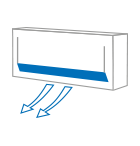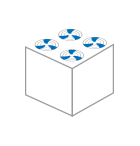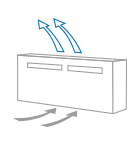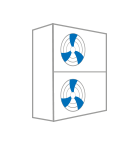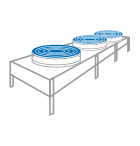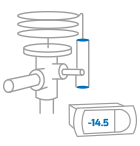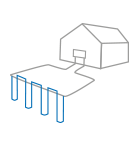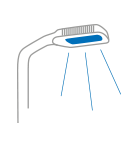The refrigeration sector is facing a historical moment. On the one hand, governments are particularly active in the creation of regulations to promote environmentally-friendly solutions
On the other, the evolution of technology is speeding up exponentially. All of this has made the refrigeration market especially competitive and constantly innovating. The objective is to provide highly efficient, safe, reliable products, with a low environmental impact, and at a reasonable price. In the case of cold rooms (also called walk-in coolers and freezers), reliability and efficiency are of particular importance, as the target is to ensure the quality of the products stored in rooms that typically operate 24 hours a day, 365 days a year.
The aim of this work is to summarise the current scenario for cold rooms and analyse the trends that will help face the new challenges.
It can be said that regulations, in particular refrigerant and energy efficiency rules, and technological advances are the two drivers of refrigeration market today.
Refrigerant regulations are currently focused on the phase down of hydrofluorocarbons (HFCs), with the aim of respecting the limits established by the Kigali Agreement signed in fall 2016, while continuing to reduce the use of refrigerants with ozone depletion potential. In Europe the global warming potential (GWP) limit established by F-gas regulation for stationary equipment, including cold rooms, is 2500 starting from 2020. This means that R-404A will have to be replaced by lower GWP refrigerants. There are different alternatives worth analysing in detail, considering that the choice of the refrigerant will determine the design of the unit, especially if the selection is R-744 (CO2). When focusing on A5 (developing) countries, such as India, the Kigali agreement defined the phase down of HFCs starting from 2029 with its first major -30% step starting from 2035.
Moreover, energy efficiency regulations aim to optimise the use of the systems and consequently reduce electricity consumption. One example involves the energy conservation standards imposed by the Department of Energy (DOE) in United States for walk-in coolers and freezers entered into force on September 8, 2017. It should be noted that the limits have the same values as the Max-Tech ones, which means that the best technology available should be used to comply with the rules. In Europe, the energy efficiency regulation (Ecodesign) for condensing units is included in ENTR Lot 1, with the introduction of the Energy Labelling based on the seasonal energy performance ratio (SEPR). According to this, since July 2018 condensing units with low SEPR can not be placed in the market anymore. SEPR takes into account variations in temperature during the year, which makes it especially important to manage the variations of load precisely. SEPR is used for condensing units with more than 5kW cooling capacity and minimum limit increases with capacity.
In this context, technological advances have been mainly focused on increasing the efficiency of devices. Recently, a new concept has emerged: the Internet of Things (IoT). In the field of refrigeration, interconnection will allow systems to be optimised by improving control through knowledge of historical data. The objective is to increase the efficiency of equipment to the highest level. The first steps have already been taken, whereas implementation and dissemination are expected to begin soon.

Trends and benefits
Selection of the most appropriate technology for cold rooms not only allows the limits set by the regulations to be met, but also guarantees that the stored products will retain their quality, as well as ensuring the reliability, safety and flexibility of the system.
First of all, it is important to provide an efficient control system with optimised and advanced control algorithms. This ensures a constant temperature and humidity in the cold room, parameters that are essential for maintaining the quality of stored food products. An optimised control system also has benefits in terms of energy efficiency, with a consequent reduction in environmental impact, two important challenges these days. Obviously, the reliability and safety of the cold room are also increased by precise control of the unit. Furthermore, configurability is highly desired, as this allows higher flexibility by giving users the possibility to select the operating conditions. An additional value comes from usability: a clear and simple control interface, a configuration wizard with multi-language guided questions, the possibility to automatically select a range of pre-set parameters values according to the user desired application improves system accessibility also to new user, saving commissioning and configuration time.
Closely related to control are alarms and supervision systems, essential in optimising energy performance and maximising savings, thus maintaining the quality of the stored products as well as ensuring operator safety. In this regard, development of the IoT is definitively bringing additional benefits: the cold room becomes now connected, its status can be monitored anytime and anywhere from a simple mobile phone, with the major value of receiving periodical feedback about its functioning, including real-time alarms reports.
Another important component in the refrigeration circuit is the expansion valve. In particular, the use of electronic expansion valves (EEV) allows adaptive adjustment of the control characteristics during operation, as well as operation with a lower pressure difference, meaning a more radical decrease in condensing temperature. This increases both system energy efficiency and reliability. To improve usability even more, and saving installation time, now on the market are available evaporators with factory fitted EEV and electronic driver. This solution allow reducing welding and cabling time, providing an electronic-embedded evaporator that can be managed directly from the main cold room controller.
Efficiency can be further improved by ad
opting inverter DC technology, allowing compressor speed and consequently unit cooling capacity to be modulated, with precise load management and constant control of the compressor envelope. This makes significant increases in unit COP possible during operation at part load, giving a higher SEPR. End-user comfort is enhanced by the noise reduction and the absence of vibration across the whole refrigeration circuit. Clearly, it also helps to maintain the quality of the stored products by keeping a constant temperature.
Installation of a humidifier in a medium temperature cold room, with a corresponding advanced control system, is highly recommended, as this ensures the minimum level of humidity (85%-90%) required to optimise fresh food preservation while preserving appearance, quality and value of the products.
Evaporative pre-cooling of the condenser units or dry and gas coolers can be applied to cut power consumption during periods of peak temperatures. Evaporative cooling exploits the natural evaporation of water, which occurs both in the intake air flow and on the coils, using the renewable heat of the outside air; this additional, sustainable cooling enhances equipment heat rejection and thus dramatically reduces power consumption. It should be noted that evaporative cooling does not add any direct global warming potential because it uses water as the coolant. Regarding its indirect effect, this is very low due to the low power consumption of the evaporative cooler; in some cases, this can be fully offset or even exceeded by the associated decrease in energy consumption of the dry/gas cooler condenser.
Last but not least, the choice of a low GWP refrigerant with high performance meets the challenge to reduce environmental impact while increasing the energy efficiency.
Available technology allows the development of highly efficient refrigeration systems for cold rooms, while ensuring the quality of the stored products and at the same time reliable, safe and flexible operation. Essential features that meet market requirements and at the same time are friendly to the environment.
CAREL is continuously developing and promoting natural, high efficiency and connected solutions, a clear response for environmental protection through optimised and integrated control systems, capable of bringing significant energy savings and consequently reducing environmental impact.
"Cella Range" is the dedicated Carel cold room product line, a complete package of solution for refrigeration professionals including advanced electronic controllers (UltraCella), electronic expansion valves and drivers (ExV Sistema), adiabatic humidifiers (Humidisk) and safety devices (Coldwatch and Gas Leakage protection).
Condensing units are powered by Carel Inverter DC Technology (Hecu), gaining even additional benefits thanks to the system approach in communication with UltraCella.
Full monitoring capabilities are provided by boss family, granting a complete local and remote cross-platform supervision.
CAREL
